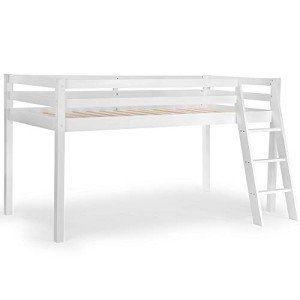The Ultimate Guide to Bunk Beds for Children: Safety, Styles, and Benefits
When it comes to styling a child's room, moms and dads often face the double difficulty of maximizing space while ensuring convenience and performance. mouse click the next site have actually emerged as a popular service that addresses these requirements, offering not simply sleeping plans but also contributing to a space's aesthetic. In this detailed guide, we will explore different aspects of children's bunk beds, focusing on their benefits, safety features, designs, and factors to consider for parents pondering this purchase.
Table of Contents
- Advantages of Bunk Beds
- Security Features to Consider
- Kinds Of Bunk Beds
- Design and Style Options
- Maintenance Tips
- Often Asked Questions (FAQs)
1. Advantages of Bunk Beds
Bunk beds use various advantages for children and their parents. Here are some key advantages:
- Space-Efficiency: Bunk beds are an excellent service for smaller sized spaces. By stacking one bed on top of another, more floor space is available for play, storage, or research study locations.
- Economical: When children share rooms, bunk beds can lower the requirement for buying 2 different beds, therefore saving cash.
- Fosters Social Interaction: Bunk beds can assist brother or sisters or pals bond by sharing a space, creating opportunities for social advancement.
- Fun Factor: The idea of sleeping "up high" includes a spirited aspect to bedtime, making the transition to sleeping alone easier for some children.
- Versatile Design: Bunk beds are available in different styles, colors, and designs to match any room theme, enabling for modification that shows the child's character.
2. Safety Features to Consider
Safety is vital when it concerns kids's furniture, specifically in the case of bunk beds. Here are some crucial security features to assess:
| Safety Feature | Description |
|---|---|
| Sturdy Construction | Frames made from strong wood or metal are preferred. |
| Guardrails | Must be at least 5 inches high and extend along both sides of the upper bunk. |
| Ladder Design | Guarantee ladders are firmly connected and have non-slip steps. |
| Bed mattress Size & & Fit | Should fit snugly within the frame to prevent spaces. |
| Weight Limit | Always stick to the producer's weight limitation suggestions. |
3. Kinds Of Bunk Beds
Bunk beds are available in a number of designs, catering to various needs, choices, and space sizes. Here are some typical types:
- Standard Bunk Bed: The most standard type, with one bed on top of another.
- Loft Bed: Features a high upper bed with space beneath for a desk or play location.
- Futon Bunk Bed: Combines a leading bunk with a futon on the bottom, providing flexibility for seating and sleeping.
- L-Shaped Bunk Bed: This style has the leading bunk set at a perpendicular angle to the bottom, creating a little corner location.
- Triple Bunk Bed: Accommodates three children using stacked beds, suitable for large households or slumber parties.
4. Style and Style Options
When it comes to selecting a design for children's bunk beds, the options are essentially endless. Here are some popular designs:
- Traditional Style: Often made of wood, these bunk beds include ornate information and are ideal for timeless or rustic-themed rooms.
- Modern Style: Characterized by tidy lines and minimalist styles, contemporary bunk beds can be made of metal or wood.
- Themed Bunk Beds: Some brand names provide bunk beds shaped like castles, automobiles, or playhouses, making bedtime less of a task.
- Convertible Bunk Beds: These can be separated into 2 individual beds, using versatility as kids grow.
- Colorful Options: Bunk beds in lively colors can include a sense of delight and playfulness to any room.
5. Maintenance Tips
Maintaining a bunk bed is important for durability and safety. Here are some ideas:
- Regular Inspections: Check for loose screws or bolts every few months and tighten them as needed.
- Cleaning up: Wipe down frames regularly to avoid dust build-up; consider utilizing a vacuum for hard-to-reach areas.
- Mattress Care: Rotate mattresses routinely and use protective covers to lengthen their life.
- Look for Wear and Tear: Look for any indications of damage in the wood or metal and think about changing parts if required.
- Teach Kids Safety Rules: Encourage children to use ladders effectively and guarantee they comprehend the safety functions of their bed.
6. Frequently Asked Questions (FAQs)
Q1: What age is suitable for sleeping in a leading bunk?
A1: Typically, children aged 6 and older are advised for upper bunk sleeping, as they have the necessary motor abilities to climb up safely.
Q2: Do bunk beds include a mattress?
A2: Most bunk beds are offered as frames only, so you will require to buy bed mattress separately. Guarantee that the mattress fits the frame comfortably.
Q3: Can bunk beds be separated later on?
A3: Many designs permit conversion into two private beds, providing versatility for future needs.
Q4: How can I ensure my child's safety on a bunk bed?
A4: Comply with security standards and make sure guardrails, a sturdy frame, and a protected ladder are in location.
Q5: Are there weight limits on bunk beds?
A5: Yes, constantly inspect the producer's specs regarding weight limitations to ensure security.
Bunk beds for kids can serve multiple functions while making sure security and design. With diverse styles and models offered on the market, moms and dads can discover a system that not only takes full advantage of bedroom space but also reflects their kid's distinct tastes. Just like any furnishings, comprehending safety functions, maintenance, and how they fit into a child's way of life will ensure that these beds remain a useful furniture solution for years to come.
Through cautious consideration and adherence to safety guidelines, bunk beds can offer a long-lasting, enjoyable, and practical sleeping service that kids like.

